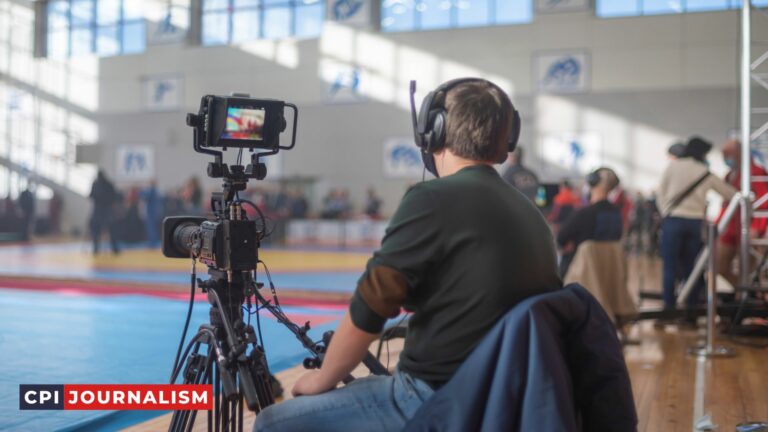How Do Sports Journalists Use Virtual And Augmented Reality In Their Storytelling?
As an experienced sports journalist, I’m excited to share my knowledge on the ways in which virtual and augmented reality can be used to enhance sports storytelling.
In recent years, the use of these technologies has exploded, as journalists have seen the potential for bringing viewers closer to the action than ever before.
In this article, I’ll explore the many ways in which virtual and augmented reality is being used to tell stories in sports journalism, giving upcoming journalists an insight into how to use this powerful new tool to bring stories to life.
A. Definition of Virtual and Augmented Reality
Virtual Reality (VR) and Augmented Reality (AR) are rapidly emerging technologies used to enhance storytelling in the realm of sports journalism.
VR immerses users in a digitally created environment, allowing them to interact with virtual objects and experiences. Whereas AR overlays digital information onto the real world, allowing users to experience a hybrid of the physical and digital worlds.
When it comes to sports journalism, VR and AR offer new ways to engage and inform viewers. For example, sports journalists can use virtual reality to transport viewers right into the middle of the action.
This could be an on-field viewpoint, an immersive press conference, or an interactive locker room tour.
Meanwhile, augmented reality can be used to enrich a broadcast or article with interactive visualizations. For example, an AR overlay could be used to show an aerial view of a football game, with the ability to zoom in on any particular play.
Or, an AR feature could be used to provide viewers with real-time stats and analysis of a particular player or team.
Overall, the possibilities that VR and AR provide for sports journalism are truly limitless. As technology continues to evolve, so too does the potential for sports journalists to create immersive, engaging stories for their viewers.
B. Benefits of Using Virtual and Augmented Reality in Sports Journalism
As an experienced sports journalist, I can attest to the many benefits of using virtual and augmented reality in sports journalism. As technology evolves, so do the capabilities of the sports journalist, providing us with new and exciting ways to tell stories.
Firstly, the use of virtual and augmented reality in sports journalism allows us to create immersive experiences that can help viewers engage and connect with the story.
Whether it is a feature piece on a sporting event or a documentary on a player’s journey, virtual and augmented reality can bring the story to life with stunning visuals and engaging audio.
Another great benefit of using virtual and augmented reality in sports journalism is the ability to take viewers inside the action.
By using 360-degree video, reporters are able to transport viewers onto the field and into the locker room, allowing them to experience the game more intimately. This can be especially useful when covering a game that is not televised.
Lastly, virtual and augmented reality can also be used to tell stories from a different perspective. By using virtual reality, reporters can recreate a game from a player’s point of view, allowing viewers to gain a better understanding of the game.
In conclusion, the use of virtual and augmented reality in sports journalism has many benefits. It allows us to create immersive experiences that can engage and connect with viewers, take them inside the action, and tell stories from a different perspective.
With the right tools and creativity, virtual and augmented reality can be used to tell incredible stories that can capture the imagination of any viewer.
II. How Sports Journalists Use Virtual and Augmented Reality
As a sports journalist, it is important to have an understanding of how to use virtual and augmented reality in your storytelling.
Virtual reality (VR) and augmented reality (AR) are two of the most popular forms of technology that allow you to create immersive experiences for viewers. VR and AR have become an essential tool for journalists to bring stories to life and engage audiences in a more meaningful way.
VR and AR can be used to tell stories in various ways. For example, sports journalists can use VR and AR to take viewers inside the action of a game or event.
This can include virtual tours of a stadium, or even giving viewers an up-close experience of the athletes themselves. VR and AR can also be used to make a story more interactive, allowing viewers to explore different aspects of a story and discover new information.
Sports journalists can also use VR and AR to create informative graphics and visuals to accompany stories. For example, a journalist can use 3D graphics to explain the rules of a particular sport or to better illustrate an athlete’s performance.
AR can be used to highlight key moments in a game or event, allowing viewers to explore the action in more detail.
Finally, sports journalists can use VR and AR to create immersive experiences for viewers. This can include virtual reality simulations of an event or game, allowing viewers to feel as if they are actually in the stadium or arena.
VR and AR can also be used to create virtual tours of a stadium or facility, allowing viewers to explore different parts of the venue.
In conclusion, virtual and augmented reality are powerful tools for sports journalists to take their storytelling to the next level.
By using VR and AR, journalists can create immersive experiences for viewers and make stories more interactive.
VR and AR can also be used to create informative visuals, graphics, and simulations, allowing viewers to explore different aspects of a story and discover new information.
A. Enhancing the Viewing Experience
Virtual and augmented reality can be used to enhance the viewing experience for sports journalists. By using these technologies, reporters are able to create immersive and realistic experiences for their viewers.
This can include providing a virtual tour of a stadium, giving fans a 3D experience of a game, or recreating key moments in an event.
For example, reporters can use a 360-degree camera to give viewers a full, immersive experience of a sporting event. They can also use augmented reality to add graphical overlays to the broadcast, provide in-depth analysis, and show important stats.
Furthermore, virtual reality can also be used to transport fans to a stadium or event that they are unable to attend. This could be done by streaming the game in VR or by creating a virtual reality experience of the game.
This gives viewers the opportunity to feel like they are actually at the event, allowing them to get a more realistic experience of the match.
Overall, virtual and augmented reality can be used to provide sports fans with a more immersive and realistic viewing experience. By using these technologies, reporters can create an experience that is both informative and engaging for their viewers.
1. Creating Immersive Experiences
As a sports journalist, one of the most powerful ways to tell a story is to create an immersive experience for your audience. Virtual and augmented reality technologies can add a layer of depth and realism that can take a simple story to the next level.
With virtual reality, sports journalists can give viewers the ability to feel like they are actually part of the game or experience.
By using a headset and accompanying controllers, viewers can be immersed in a 3D environment that provides a realistic experience. This technology can be used to create a virtual sports stadium, where viewers can stand in the stands and watch the game as if they were actually there.
Augmented reality, on the other hand, allows sports journalists to layer virtual elements on top of the real world. This can be used to enhance the viewing experience by adding digital overlays that provide additional information, such as stats and replays.
Augmented reality can also be used to give viewers a more interactive experience, with polls, quizzes, and other interactive elements.
Using these technologies, sports journalists can create immersive experiences that draw viewers in and give them a better understanding of the story.
By allowing viewers to engage with the content in a more meaningful way, these technologies can create a more engaging and memorable experience.
2. Enhancing the Visuals
As a sports journalist, you know that visuals are a major element in storytelling. Virtual and augmented reality (VR and AR) can help you create more engaging and captivating visuals that will draw your audience in.
With VR and AR, you can craft immersive and interactive experiences that will take sports journalism to the next level.
First and foremost, you can use VR and AR to create 3D models and simulations of sports venues, equipment, and players. This will give viewers a much more realistic view of the game and will help them to connect with the story on an emotional level.
You can also create interactive experiences such as virtual tours, giving viewers a firsthand look at the sports environment.
AR can also be used to create immersive experiences for the audience with interactive overlays. You can overlay stats, facts, or other information onto the game, giving viewers a more comprehensive understanding of the sport.
For example, you can provide real-time updates on the game which will help to keep the audience engaged. This can be especially helpful for sports teams who are looking to promote their game and engage with fans.
Finally, AR can be used to create interactive content such as games, quizzes, and quizzes. This will help to engage viewers and make the story more enjoyable to follow.
By creating interactive experiences, you can increase the appeal of sports journalism and make it more accessible to a wider audience.
In summary, virtual and augmented reality can provide a new level of visual storytelling for sports journalism.
By creating 3D models and simulations, interactive experiences, and interactive content, you can create a more immersive experience for viewers and make sports journalism more engaging and captivating.
B. Enhancing the Storytelling
As a sports journalist, it is important to tell the story in an engaging and captivating way. This is where virtual and augmented reality technology can help to enhance the storytelling process.
Virtual reality allows viewers to feel as if they are in the moment, in the sports game, and even behind the scenes. Augmented reality gives journalists the ability to overlay text, images, and video onto a real-world setting.
Virtual reality technology can be used to create an immersive experience for viewers. In a basketball game, for example, a journalist can create a 360-degree video of the game, allowing viewers to feel as if they are actually courtside witnessing the action.
This technology can also be used to create a virtual tour of a stadium or arena, allowing viewers to explore the venue and better understand the atmosphere.
Augmented reality technology can be used to supplement the storytelling process. For example, a journalist can use AR to overlay text and images onto a real-world setting.
This can include displaying player stats, team standings, or other relevant information alongside the actual game or match. AR can also be used to create interactive graphics or illustrate key plays or moments in the game.
By utilizing virtual and augmented reality technology, sports journalists can create a more immersive and engaging experience for viewers.
This technology can also be used to supplement the storytelling process, providing viewers with a more comprehensive understanding of the game or match.
1. Creating Interactive Content
As a sports journalist, one of the most exciting ways to use virtual and augmented reality in your storytelling is to create interactive content. This type of content engages your audience, allowing them to get closer to the action and feel like they are part of the story.
One way to do this is to create 360-degree videos that viewers can pan around and explore. This allows them to immerse themselves in the story, providing an experiential element that they can’t get from a traditional news article or video.
Additionally, you can use augmented reality to overlay graphics and other visual elements onto the video, giving viewers an even more interactive experience.
Another popular way to create interactive content is to use virtual reality simulations. These simulations allow you to recreate sporting events in a virtual environment, letting viewers experience them firsthand.
This can help viewers connect to the story on a deeper level, as they are able to explore the simulated environment and interact with the characters within it.
Finally, you can also use augmented reality to create interactive content. This can include anything from overlaying graphics onto a video to creating interactive 3D models or animations.
This can be a great way to bring the story to life, allowing viewers to explore and engage with the content in a more immersive way.
Overall, creating interactive content is a great way to use virtual and augmented reality in your storytelling.
It allows you to provide viewers with an experiential element that they can’t get from traditional storytelling, allowing them to get closer to the action and engage with the story on a deeper level.
2. Enhancing the Narrative
Virtual and augmented reality (VR/AR) are powerful tools that sports journalists can use to enhance their storytelling. By combining the power of immersive visuals, sound, and interactivity, VR/AR can transport viewers to the heart of the action, creating an entirely new level of engagement.
A prime example of how VR/AR can be used to enhance the narrative is with 360-degree videos. These videos allow viewers to experience the story from multiple perspectives, providing a more immersive and interactive experience.
This technology can be used to take viewers inside the locker room, onto the field, and even into the stands to get a firsthand, 360-degree view of the action.
Another way to enhance the narrative with VR/AR is through the use of 3D/4D animation. This technology can be used to bring life to statistics and data, providing viewers with a clearer understanding of the game and what is happening on the field.
For example, 3D/4D animation can be used to show the trajectory of a ball, graphically illustrating the movements of players and coaches, and providing an overall more engaging experience.
Finally, augmented reality is a powerful tool that can be used to enhance the narrative of sports journalism.
By combining real-world footage with virtual elements, journalists can create an immersive experience that can be further enhanced with voice-over commentary, animations, and interactive elements.
This technology can be used to provide viewers with an in-depth look at the game, allowing them to see what the players see, feel what the players feel, and get an even deeper understanding of the story.
3. Utilizing 3D and 360-degree Video
As a sports journalist, one of the greatest tools at your disposal is 3D and 360-degree video. This type of video allows viewers to get an up-close and personal view of the action and provides a powerful storytelling tool.
In sports, 3D and 360-degree video gives viewers a complete, immersive experience as they watch from any angle – from the sidelines to the center of the action. Viewers can also enjoy a sense of depth that traditional 2D video cannot provide.
360-degree video can be used for a variety of sports stories, from in-depth profiles of athletes to behind-the-scenes looks at a team or event. It can also be used to capture the intensity and excitement of a live sporting event, giving viewers the feeling of actually being at the game.
3D video can also be used to create a more dramatic and lifelike experience for viewers. By providing viewers with a more realistic view of the action, 3D video can help to bring the game to life.
The use of 3D and 360-degree video is becoming increasingly popular in sports journalism and can be a great tool for telling impactful and engaging stories.
It is important to use this type of video wisely, however, as it can be easy to overuse or misuse it. Make sure that you use 3D and 360-degree video to enhance your story, not to distract from it.
III. Challenges Faced by Sports Journalists
Sports journalists face a number of hurdles when it comes to utilizing virtual and augmented reality in their storytelling.
While the technology itself can be a powerful tool to capture and tell stories, it is also a relatively new technology and can be intimidating or difficult to learn how to use.
Additionally, many sports teams, leagues, and organizations are still reluctant to adopt or invest in VR or AR technology, making it difficult for journalists to access the necessary tools.
Another challenge is the expense of the technology itself. While there are more affordable options available, the cost of equipment and software can still be quite high and may be prohibitive for some journalists.
Additionally, some of the more advanced pieces of technology still require specialized training and knowledge in order to use them, adding to the cost and complexity of the process.
Finally, as with any technology, there is the potential for technical difficulties and errors which can lead to delays in the production process and can also be costly to fix.
This is especially true for virtual and augmented reality, as the technology is still developing and evolving. As a result, journalists must be prepared for potential technical delays and be willing to invest the time and resources to learn and troubleshoot any issues that arise.
A. Cost of Technology
One of the major concerns for sports journalists when it comes to using virtual and augmented reality technology in their storytelling is the cost associated with the technology.
But it’s important to know that while the upfront cost of the technology might be significant, the long-term benefits of using this technology far outweigh the initial cost.
For example, the cost of purchasing a high-end virtual reality headset, such as an Oculus Rift or HTC Vive, can range from $400 to $800.
Then you’ll need to add in the cost for the necessary hardware such as a powerful gaming PC, which can range from $600 to $3000.
Plus, you’ll need to consider the cost of a good quality camera, microphone and lighting equipment in order to capture high-quality footage for your story.
However, the cost of virtual and augmented reality technology is decreasing rapidly, with more and more options becoming available at lower prices. In addition, there are now affordable and easy-to-use VR and AR platforms that allow journalists to create stories without needing to invest in expensive hardware.
Plus, by using virtual and augmented reality technology, you can reduce the need for costly travel expenses and time spent in the field.
This technology can allow you to create stories with a fraction of the cost and time compared to traditional methods, while also creating a more immersive experience for your audience.
Overall, the cost of virtual and augmented reality technology is worth the investment for any sports journalist that is looking to create innovative and engaging stories.
With the right equipment and platform, you can create stories that will reach a larger audience and give them a more immersive experience.
B. Lack of Technical Knowledge
One of the biggest challenges for sports journalists when it comes to using virtual and augmented reality in their storytelling is their lack of technical knowledge.
While many journalists have a basic understanding of the technology, they often lack the in-depth knowledge necessary to effectively use it in their work.
The technical aspects of virtual and augmented reality can be complex and require a great deal of expertise. It is not enough to simply understand the technology; one must also be able to use it effectively and efficiently.
This requires a level of technical skill and understanding that many sports journalists may not have.
As such, it is important for sports journalists to invest the time and effort necessary to develop their technical knowledge and skills.
This can mean taking courses, reading technical manuals, or even learning from mentors. Doing so will not only help them use virtual and augmented reality more effectively in their work, but also opens up a wide range of opportunities to enhance their storytelling.
C. Limited Access To Equipment
Sports journalists are always looking for ways to tell the story of a game or tournament in a more compelling way, and the use of virtual and augmented reality (VR/AR) can be an invaluable tool in this regard. Unfortunately, access to the necessary equipment to create a VR/AR experience can be limited.
For starters, the hardware and software needed to create a VR/AR experience can be costly. Professional-grade VR/AR equipment can range from thousands to tens of thousands of dollars. Not all sports journalists have the budget to purchase or rent the necessary equipment.
Furthermore, many VR/AR applications require specialized skills and knowledge to effectively use the technology.
It can take time for a journalist to become proficient in the use of the technology, and even then, it might not be the most efficient way to tell the story.
In addition, there are a few challenges associated with the use of VR/AR equipment. For example, the equipment is bulky and can be difficult to transport.
This can be a problem in sports journalism, where journalists often need to travel to different venues to cover an event.
Finally, many venues may not have the necessary infrastructure to support the use of VR/AR technology. This can be a major obstacle for a journalist who is trying to tell the story of an event in an immersive way.
Despite these challenges, VR/AR technology can be a powerful tool for sports journalists, providing them with a novel way of telling stories and engaging audiences.
While access to the necessary equipment might be limited, there are still ways that journalists can make use of the technology. For instance, journalists can make use of mobile phone-based applications that provide a basic introduction to the technology.
In addition, journalists can collaborate with other professionals who have access to the necessary equipment and expertise.
IV. Conclusion
In conclusion, virtual and augmented reality have revolutionized the way sports journalists tell stories. They allow reporters to provide a more immersive experience for their audiences and to better capture the emotion and atmosphere of the event.
By using these tools, journalists can bring their stories to life and bring viewers closer to the action.
Furthermore, virtual and augmented reality technologies can help reporters to produce more accurate and compelling stories. By using these tools, sports journalists can create stories that are more immersive and engaging.
Additionally, virtual and augmented reality provide reporters with the opportunity to use real-time data to enhance their stories, allowing them to provide more in-depth analysis of a given event or game.
In short, virtual and augmented reality are changing the way sports journalists tell stories. By using these tools, reporters can provide a more immersive experience, incorporate real-time data to enhance their stories, and create more accurate and compelling stories.
With these tools, sports journalists can bring their stories to life and bring viewers closer to the action.
A. Summary of How Sports Journalists Use Virtual and Augmented Reality
Sports journalists have embraced virtual and augmented reality technologies, as a way to provide a more immersive, interactive and engaging experience for their readers.
Virtual reality (VR) and augmented reality (AR) allow sports journalists to tell stories in a whole new way, taking readers into the action, allowing them to explore and experience events as if they were there.
VR and AR technologies can help sports journalists to create new experiences for the reader, such as giving them the ability to explore the stadium, player locker rooms and other sports venues.
Journalists can also create virtual interviews with players and coaches, giving readers the opportunity to interact with them and ask questions.
By using VR and AR, sports journalists can also create interactive 3D simulations of sports games and events, allowing readers to experience a live game as if they were in the stadium.
Furthermore, journalists can create interactive experiences for readers, such as navigating through virtual replicas of sports venues and exploring data visualizations.
In conclusion, sports journalists are utilizing the latest virtual and augmented reality technologies to provide an immersive and interactive experience for their readers.
They are creating virtual experiences, interactive 3D simulations and data visualizations, allowing readers to experience sports events and games as if they were there.
B. Benefits of Using Virtual and Augmented Reality in Sports Journalism
As a sports journalist, one of the greatest benefits of using virtual and augmented reality in storytelling is the ability to provide a more immersive and engaging experience for the reader.
VR and AR technologies provide a unique way to bring a story to life, taking the reader on a journey that has never been possible before.
There are many ways that sports journalists can utilize the power of VR and AR to create compelling stories. For example, when covering a game, VR can be used to provide a 360-degree view of the stadium, giving the reader a true sense of being there.
AR can be used to provide interactive visuals and 3D models that can further enhance the story, providing a more comprehensive understanding of the game.
Additionally, VR and AR can be used to give readers access to exclusive content that they would never be able to see otherwise. This could include an in-depth look at the players and coaches, or a behind-the-scenes look at the preparation that goes into a game or tournament.
Finally, VR and AR can be used to take readers to places they would never be able to experience in person.
This could include the locker room of a professional team, or the court of a famous tournament. By providing these exclusive experiences, sports journalists can create stories that are truly unforgettable.
C. Future of Sports Journalism and Virtual and Augmented Reality
As technology advances, so does the potential for sports journalism to use virtual and augmented reality for storytelling.
With the ever-increasing capabilities of virtual and augmented reality technology, sports journalists now have the opportunity to create immersive experiences for their audiences to explore and engage with.
The future of sports journalism lies in the ability to use virtual and augmented reality to create an immersive experience for the viewer.
This technology can be used to provide fans with the opportunity to experience a game in a realistic way, such as being able to see a game from the perspective of a player or coach.
As technology continues to evolve, sports journalists will be able to create even more complex and interesting experiences for viewers.
The potential for virtual and augmented reality in sports journalism is limited only by the imagination of the journalist.
As technology evolves, more opportunities will become available for sports journalists to create unique and engaging content for their audiences.
In addition, virtual and augmented reality technology will also enable sports journalists to create more accurate and detailed stories that can be experienced by viewers.
This technology could be used to provide viewers with a realistic view of a particular event or game as it is happening, allowing for a more in-depth and detailed story than would be possible with traditional media.
The future of sports journalism and virtual and augmented reality is incredibly exciting and presents a wealth of opportunities for sports journalists to create unique and engaging stories for their audiences.
With the continuing evolution of technology, the possibilities for sports journalism to use virtual and augmented reality in the future are virtually limitless.







